
http://www.iaeme.com/IJM/index.asp 8 editor@iaeme.com
International Journal of Management (IJM)
Volume 8, Issue 5, Sep–Oct 2017, pp.8–14, Article ID: IJM_08_05_002
Available online at
http://www.iaeme.com/ijm/issues.asp?JType=IJM&VType=8&IType=5
Journal Impact Factor (2016): 8.1920 (Calculated by GISI) www.jifactor.com
ISSN Print: 0976-6502 and ISSN Online: 0976-6510
© IAEME Publication
CONSUMER AWARENESS TOWARDS GREEN
PRODUCTS
P. Asha
Research Scholar, Women‟s Christian College,
Nagercoil. Tamilnadu, India
R. Rathiha
Associate Professor, Women‟s Christian College,
Nagercoil, Tamilnadu, India
ABSTRACT
Consumer’s awareness about green products is important in guiding the green
consumer purchasing behavior. The study brings out green product awareness among
the consumers in Kanyakumari District. The main objective of this study is to know the
consumer awareness about green products. The data was collected from 123
respondents. Secondary data was collected from the available literature sources. The
core idea of green marketing is to create awareness among people on the
environmental issues and how consumers would be helping the environment if they
switch over to green products. Thus green marketing aims to provide more
information to people and also gives consumers more choices to switch over to green
lifestyle.
Key words: green product, green attribute, environmental degradation, consumer
awareness.
Cite this Article: P. Asha and R. Rathiha, Consumer Awareness Towards Green
Products. International Journal of Management, 8 (5), 2017, pp. 8–14.
http://www.iaeme.com/IJM/issues.asp?JType=IJM&VType=8&IType=5
1. INTRODUCTION
As the world‟s economy is hurriedly developing, the global environment is increasingly
weakening. Protecting environment and creating a safe living environment has become one of
the most important concerns of consumers. Green marketing generally aims to encourage
environmentally friendly products and a safe environment where people can stay. According
to the American Marketing Association green marketing is the marketing of products that are
presumed to be environmentally safe. At present green marketing is broadly becoming a
phenomenon throughout the world as concerns towards environment have begun in the past
few decades. Every year the populations of people who are rotating towards green brands or
environmental friendly products are increasing thus magnifying the phenomenon. The need
for sustainable business practices by corporations around the world is identified to be a result

Consumer Awareness Towards Green Products
http://www.iaeme.com/IJM/index.asp 9 editor@iaeme.com
of overall increase in the consumer awareness of lack of environmental protection and social
inequities. Thus, businesses in nearly every industry nowadays want to protect “green”
features of their products and services in every chance they get. The success of any green
marketing strategy is heavily dependable on its target consumers.
The core idea of green marketing is to create awareness among people on the
environmental issues and how consumers would be helping the environment if they switch
over to green products. Thus green marketing aims to provide more information to people and
also gives consumers more choices to switch over to green lifestyle. Driven by the green
consumption, enterprises begin to take customer as the guide of the green marketing strategy.
A green consumer can be identified to be one who avoids any product which may harm
damage to any living organism, cause deterioration of the environment during process of
manufacturing or during process of usage, consume a large amount of nonrenewable energy,
involves unethical testing on animals or human subjects (Elkington, 1994).
2. REVIEW OF LIERATURE
The study by Hari Sundar G. Ram et al. (2011) identified that the decision-making styles as
Perfection/high quality-conscious consumer, Brand Consciousness, Novelty, Shopping
Consciousness, Price Consciousness, Impulsiveness, Choice and Brand loyalty.
The study by Moloy Ghoshal (2011) examined that green marketing was still in infancy.
In the perception of marketing scholars, green marketing refers to eco-level and market
segmentation and the role of structural factors and economic incentives in influencing
consumer behavior. The green marketers must understand to satisfy two objectives: improved
environmental quality and customer satisfaction.
Charles W Lamb et al (2004) explained that Green Marketing‖ has also become an
important way for companies to build awareness and loyalty by promoting a popular issue. By
positioning their brands as ecologically sound, marketers can convey concern for the
environment and society as a whole.
According to Roger A Kerin et al (2007), Green Marketing takes many forms. It comes
from product development opportunities that emanate both from consumer research and its
Pollution Prevention Pays‖ program. This program solicits employee suggestions on how to
reduce pollution and recycle materials.
The study by Meenakshi Handa(2006) has indicated that Activist groups and the media
have played a major role in enhancing the environmental awareness and consciousness of
consumers in recent years. Most studies on the subject show that although the awareness and
environmental behavior of consumers across countries, educational levels, and age and
income groups may differ, environmental concerns are increasing worldwide.
3. OBJECTIVES
The impacts of respondents demographic variables on their awareness towards green products
Consumer awareness towards consequence of environment degradation
To understand insight the ability to identify green attributes in green products
Impact of gender on the ways of identifying green products
4. RESEARCH METHEDOLOGY
A descriptive research was undertaken to meet the objectives of this study with the collection
of both secondary and primary data. The primary data was collected from respondents in

P. Asha and R. Rathiha
http://www.iaeme.com/IJM/index.asp 10 editor@iaeme.com
Kanyakumari District through a questionnaire designed for a sample of 123 respondents,
samples from Kanyakumari District representing, both genders, different age groups,
education level, marital status, employment and monthly income. A structured questionnaire
with a five point likert scale technique for measuring consumer awareness towards green
marketing has been used. The data collected from the respondents are tabulated and analyzed
into logical statements using percentage, chi-square and mean score analysis. Secondary data
was collected from the available literature, journals and web search.
5. IMPACT OF DEMOGRAPHIC PROFILE ON GENDERWISE
CONSUMER AWARENESS
The demographic variables taken into consideration for the analysis of gender wise consumer
awareness are age, educational level, marital status, employment and monthly income. The
following table 1.1 presences the analysis.
Table 1 Demographic profile of the respondents on their awareness towards green products
Sl. No.
Variables
Gender
Total
X2
P Value
Male
Female
1.
Age
Up to 20
21-30
31-40
41-50
51-60
Above 60
3
(5.26)
17
(29.82)
28
(49.12)
3
(5.26)
2
(3.50)
4
(7.01)
2
(3.03)
49
(74.24)
8
(12.12)
2
(3.03)
3
(4.54)
2
(3.03)
5
(4.06)
66
(53.65)
36
(29.26)
5
(4.06)
5
(4.06)
6
(4.87)
27.381
.000
Total
57
66
123
2.
Educational Qualification
Up to High Secondary
Graduate
Post graduate
Professionals
Others
1
(1.75)
8
(14.03)
37
(64.91)
10
(17.54)
1
(1.75)
4
(6.06)
11
(16.66)
37
(56.06)
13
(19.69)
1
(1.51)
5
(4.06)
19
(15.44)
74
(60.16)
23
(18.69)
2
(1.62)
2.017
.733
Total
57
66
123
3.
Marital status
Married
Unmarried
46
(80.70)
26
(45.61)
11
(16.66)
40
(60.60)
72
(58.53)
51
(41.46)
21.502
.000
Total
57
66
123
4.
Employment
Private employees
Govt. employees
Business
Service
39
(68.42)
6
(10.52)
1
(1.75)
5
(8.77)
6
21
(31.81)
4
(6.06)
1
(1.51)
27
(40.90)
13
60
(48.78)
10
(8.13)
2
(1.62)
32
(26.01)
19
22.968
.000

Consumer Awareness Towards Green Products
http://www.iaeme.com/IJM/index.asp 11 editor@iaeme.com
Others
(10.52)
(19.69)
(15.44)
Total
57
66
123
5.
Monthly income
Up to 20,000
21,000-30,000
31,000-40,000
41,000-50,000
Above 50,000
1
(1.75)
40
(70.17)
1
(1.75)
9
(15.78)
6
(10.52)
2
(3.03)
24
(36.36)
7
(10.60)
13
(19.69)
20
(30.30)
3
(2.43)
64
(52.03)
8
(6.50)
22
(17.88)
26
(21.13)
16.529
.002
Total
57
66
123
Source: Primary Data
The above table reveals that except for educational qualification all the other demographic
variable namely, age, marital status, employment and monthly income have significant impact
on the gender wise awareness level of respondents about the usage of green products.
Another important fact proved in this study is that 60 percent of the post graduate respondents
are aware of the usage of green products. Regarding the married respondents 59 percentage
are familiar with the need to use green products. Another interesting fact is 49 percent of the
respondents working in private organisations are aware of the need to use green products.
Majority of the respondents that is 64 percent, in the group of income 21,000-30,000, have
awareness towards the usage of green products. It is hearting to note the fact that the young
generations in the group of 21-30 are aware (54 percent) are aware of need to use green
products.
6. AWARENESS TOWARDS CONSEQUENCE OF ENVIRONMENT
DEGRADATION
The environment degradation leads to many problems that would affect the lifestyle of the
people. This study analyzes the awareness level of the respondents on the consequence of
environment degradation and the results are given below table 2.
Table 2 Consequences of Environment Degradation
Sl. No.
Consequences of
environment degradation
Male
Female
Overall
Mean
score
Rank
Mean
score
Rank
Mean
score
Rank
1.
Global warming
4.09
I
4.41
I
4.26
I
2.
Climate change
3.93
II
4.32
II
4.14
II
3.
Destruction of ozone
3.89
III
4.27
III
4.10
III
4.
Hazardous waste
4.09
I
3.97
IV
4.02
IV
5.
Contamination of drinking
water
3.53
VI
3.95
V
3.76
V
6.
Health problem to human
beings
3.56
V
3.91
VI
3.75
VI
7.
Acid rain
3.35
VII
3.61
VIII
3.49
VIII
8.
Endangered species
3.58
IV
3.35
IX
3.46
IX
9.
Scarcity of rain
3.25
VIII
3.35
IX
3.30
X
10.
Reduction of natural resources
3.25
VIII
3.89
VII
3.59
VII
11.
Toxic substances in the
environment
2.93
IX
2.97
X
2.95
XI
Source: Primary Data

P. Asha and R. Rathiha
http://www.iaeme.com/IJM/index.asp 12 editor@iaeme.com
The table 2 reveals that both the male and female respondents states that the three main
consequence of environment degradation are global warming, climate change and destruction
to ozone layer.
7. IDENTIFICATION OF GREEN PRODUCT ATTRIBUTES
If one needs to use green products, he should be aware the ways to identify green attributes
that decides whether a products is green or not. The consumer should be aware of the features
of the green products. The analysis in this regards is made and the result is given below the
table no. 3.
Table 3 Attributes of green products
Sl.
No.
Awareness
Male
Female
Overall
Mean
score
Rank
Mean
score
Rank
Mean
score
Rank
1.
Recyclable
4.00
I
3.82
VIII
3.90
III
2.
Non-toxic
3.79
IV
4.03
II
3.92
II
3.
Made from recycled waste
or made from natural of
renewable materials
3.37
X
3.79
IX
3.59
VIII
4.
To product with natural
ingredients
3.70
V
3.85
VI
3.78
VI
5.
Eco-friendly packaging
3.98
II
4.32
I
4.16
I
6.
Originally developed
products
3.49
VIII
3.86
V
3.69
VII
7.
Low embodied energy
3.58
VI
4.00
IV
3.80
V
8.
Product that will not be
tested on animals
3.81
III
3.83
VII
3.82
IV
9.
Non polluting
3.54
VII
4.02
III
3.80
V
10.
Healthy for occupants
3.39
IX
3.55
X
3.47
IX
Source: Primary Data
The above table reveals that the main three green attributes known to the male
respondents are recyclable nature of the product; eco-friendly packaging and the products will
not be tested on animals. The female respondents say that the three main green attributes they
can identify are eco-friendly packaging, non-toxic products and pollution free products. The
overall results show that the three green attributes that can easily be identified are eco-friendly
packaging, non-toxic products and the recyclable nature of the products.
8. THE WAYS OF IDENTIFYING GREEN PRODUCTS
Now a day the green products use different green symbols and labels to help the consumers to
identify the green products. This study analyze whether the respondents are able to identify
the symbols, labels, logos and green brands and the result is given below.



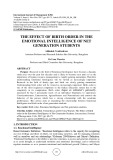
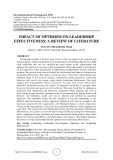
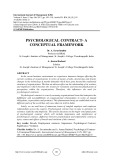
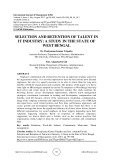

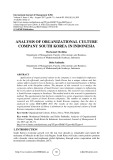
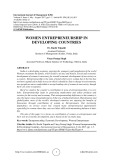
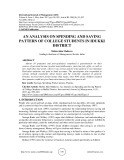


![Câu hỏi ôn tập Tâm lý học quản lý [chuẩn nhất]](https://cdn.tailieu.vn/images/document/thumbnail/2025/20251125/hathunguyen04er@gmail.com/135x160/25191764124376.jpg)
![Cẩm nang chăm sóc và nuôi dạy trẻ tăng động giảm chú ý [chuẩn nhất]](https://cdn.tailieu.vn/images/document/thumbnail/2025/20251118/kimphuong1001/135x160/4241763431998.jpg)


![Sổ tay Hướng dẫn tự chăm sóc trầm cảm [chuẩn nhất]](https://cdn.tailieu.vn/images/document/thumbnail/2025/20251029/kimphuong1001/135x160/3711761720335.jpg)
![Đề cương Tâm lý học xã hội [chuẩn nhất]](https://cdn.tailieu.vn/images/document/thumbnail/2025/20251028/c.dat0606@gmail.com/135x160/99271761707421.jpg)
![Câu hỏi ôn thi Nhập môn khoa học nhận thức [chuẩn nhất]](https://cdn.tailieu.vn/images/document/thumbnail/2025/20251021/aduc03712@gmail.com/135x160/48471761019872.jpg)

![Đề cương môn Tâm lý học sinh tiểu học [chuẩn nhất]](https://cdn.tailieu.vn/images/document/thumbnail/2025/20251007/kimphuong1001/135x160/51781759830425.jpg)



![Tâm lí học lứa tuổi và sư phạm ở tiểu học: Bài thuyết trình [chuẩn nhất]](https://cdn.tailieu.vn/images/document/thumbnail/2025/20250918/vuhoaithuong14@gmail.com/135x160/90941758161117.jpg)
